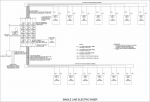classicaldg
Member
- Location
- San Luis Obispo, CA
- Occupation
- Architect
Hello,
My architecture firm has in-house electrical designers, and we are currently working on a condo building electrical system replacement. The building has two wings of condos and was built in 1924. The electrical system will be entirely new.
From the main electrical meter panel, a 3" conduit that carries the electrical panel feeds to each condo unit goes underground to each of the wings, then up the exterior wall to the attic of each wing. From there, the electrical feeds go to each condo unit.
From where the 3" conduit enters the attic space, what is the most cost effective way to run the electrical panel feeds to each condo unit. Is it a gutter that attaches to the 3" conduit and that runs the length of the attic, then above each condo unit, a conduit will be attached to the gutter and run down to each condo unit electrical panel?
Or is there another way to distribute the electrical feeds from the 3" conduit to each condo unit.
Thank you - classicaldg
My architecture firm has in-house electrical designers, and we are currently working on a condo building electrical system replacement. The building has two wings of condos and was built in 1924. The electrical system will be entirely new.
From the main electrical meter panel, a 3" conduit that carries the electrical panel feeds to each condo unit goes underground to each of the wings, then up the exterior wall to the attic of each wing. From there, the electrical feeds go to each condo unit.
From where the 3" conduit enters the attic space, what is the most cost effective way to run the electrical panel feeds to each condo unit. Is it a gutter that attaches to the 3" conduit and that runs the length of the attic, then above each condo unit, a conduit will be attached to the gutter and run down to each condo unit electrical panel?
Or is there another way to distribute the electrical feeds from the 3" conduit to each condo unit.
Thank you - classicaldg



